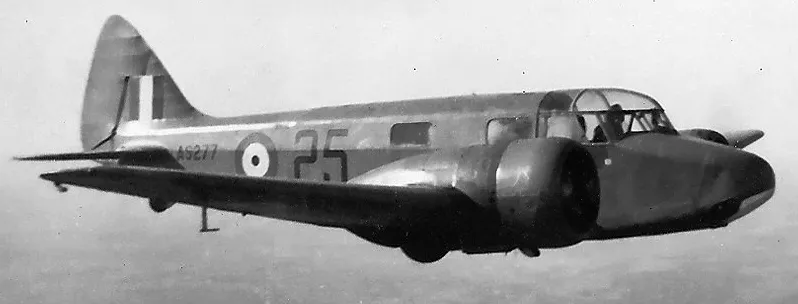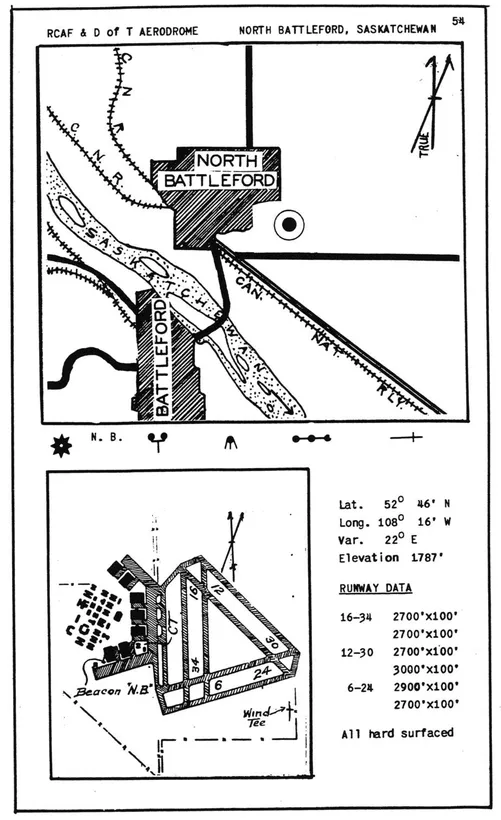Oxford serial: AS347
(Bob Brown Photo)(Source Harold A Skaarup Web Page)
Airspeed A.S. 10 Oxford Mk. II, RCAF (Serial No. AS277), 25, in flight over Saskatchewan, 1942.
The Airspeed AS.10 Oxford was a twin-engine monoplane aircraft developed and manufactured by Airspeed. It saw widespread use for training British Commonwealth aircrews in navigation, radio-operating, bombing and gunnery roles throughout the Second World War.
The Oxford was developed by Airspeed during the 1930s in response to a requirement for a capable trainer aircraft that conformed with Specification T.23/36, which had been issued by the British Air Ministry. Its basic design is derived from the company's earlier AS.6 Envoy, a commercial passenger aircraft. Performing its maiden flight on 19 June 1937, it was quickly put into production as part of a rapid expansion of the Royal Air Force (RAF) in anticipation of a large-scale conflict.
As a consequence of the outbreak of war, many thousands of Oxfords were ordered by Britain and its allies, including Australia, Canada, France, New Zealand, Poland, and the United States. Following the end of the conflict, the Oxford continued to achieve export sales for some time, equipping the newly formed air forces of Egypt, India, Israel, and Yugoslavia. It was considered to be a capable trainer aircraft throughout the conflict, as well as being used a general-purpose type. A large number of Oxfords have been preserved on static display.
Wikipedia
 Oxford Trainer
Oxford Trainer
 Wikipedia Oxford Trainer
Wikipedia Oxford Trainer
 Harold A Skaarup Web Page
Harold A Skaarup Web Page
Aircraft Images
Oxford AS347
Oxford Mk. II AS347
Taken on strength at No. 2 Elementary Flying Training School at Fort William, Ontario. To No. 2 Training Command on 10 September 1941, for use by No. 35 Service Flying Training School at North Battleford, Saskatchewan. To No. 4 Training Command with this School on 10 November 1941. To Aircraft Repair in Edmonton for overhaul, 20 March to 12 August 1943. Back to No. 4 Training Command when completed. Still with No. 35 Service Flying Training School when it crashed on 2 December 1943, near North Battleford. Both RAF occupants killed. Note that Record Card reports crash date correctly, but lists write off date as 13 March 1943.
1941-08-20 Taken on Strength No. 2 Training Command
2019-08-20
1943-03-13 Struck off Strength Struck off, reduced to spares and produce
2020-09-22
1943-December-02 Accident: 35 Service Flying Training School Loc: Aerodrome Names: Cheetham | Clarke | Tomalin
Unit Desciption
35 SFTS (35 Service Flying Training School)
Graduates of the EFTS "learn-to-fly" program went on a Service Flying Training School (SFTS) for 16 weeks. For the first 8 weeks the trainee was part of an intermediate training squadron; for the next 6 weeks an advanced training squadron and for the final 2 weeks training was conducted at a Bombing & Gunnery School. The Service schools were military establishments run by the RCAF or the RAF.
There were two different types of Service Flying Training Schools. Trainees in the fighter pilot stream went to an SFTS like No. 14 Aylmer, where they trained in the North American Harvard or North American Yale. Trainees in the bomber, coastal or transport pilot stream went to an SFTS like No. 5 Brantford where they learned multi-engine technique in an Airspeed Oxford, Avro Anson or Cessna Crane.
RCAF Aerodrome North Battleford, Saskatchewan.
Image from the RCAF Pilots Manual of Aerodromes and Seaplane Bases circa 1942.
For More Information on RCAF Station North Battleford see here
 RCAF.Info - RCAF Station North Battleford SK
RCAF.Info - RCAF Station North Battleford SK
 RCAF.Info - Relief Landing Field Hamlin SK
RCAF.Info - Relief Landing Field Hamlin SK
 RCAF.Info - Relief Landing Field Brada SK
RCAF.Info - Relief Landing Field Brada SK
 Elinor Florence - Brada Relief Field - Air Force Ghosts
Elinor Florence - Brada Relief Field - Air Force Ghosts
 Saskatchewan Virtual War Memorial - Base History
Saskatchewan Virtual War Memorial - Base History
 Vintage Wings - Ghosts Of Saskatchewan
Vintage Wings - Ghosts Of Saskatchewan
 YouTube - Abandoned Saskatchewan
YouTube - Abandoned Saskatchewan
Project 44 BCATP
 Project 44 BCATP
Project 44 BCATP
 YouTube - Valour Canada Aerodrome of Democracy
YouTube - Valour Canada Aerodrome of Democracy



